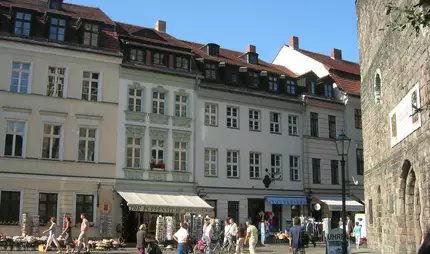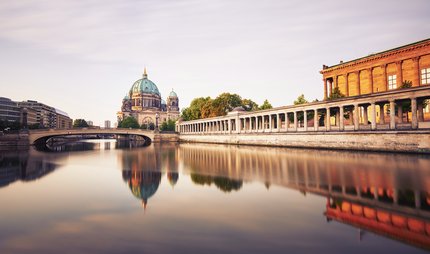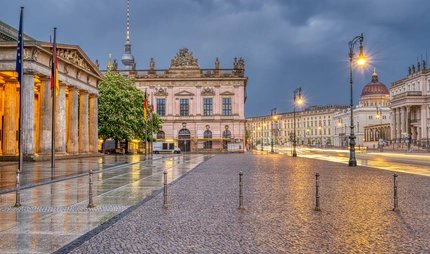
Museum Ephraim-Palais | Stadtmuseum Berlin
Reopening from 1 December
Not far from the Museum Island, the Ephraim Palace shines in a proud rococo setting. The "most beautiful corner of Berlin" is one of the most magnificent town houses in the capital. The gently rounded corner façade with gilded balcony lattice and Tuscan columns is an eye-catcher.
From 1 December, the four-story gem in the Nikolai quarter will be open to visitors again. The exhibition BerlinZEIT - The city makes history.
A journey into the 18th century
The building has an eventful history. It is completed in 1766 by the architect Friedrich Wilhelm Diterichs for the affluent Veitel-Heine Ephraim, jeweller to the Prussian Court and Mint Master. In Nazi Germany, the palace, which is part of the Jewish history of Berlin, undergoes building works. It is adapted to be a base for regional management and other National Socialist administration. Miraculously, the façade and other parts of this beautiful building survive the war. After the Berlin wall is built, the West Berlin Senate plan to use parts of the Ephraim-Palais for the Berlin Museum.
However, since the blueprints are located in East Berlin, the plan never comes to pass. In the 1980s, when both sides of Berlin are preparing to celebrate the city's 750-year anniversary, the palace gives up some building components, and in return receives the archive of the Royal Porcelain Factory from the East Berlin municipal authorities. Between 1985 and 1987 the palace is rebuilt following its original blueprints in the newly developed Nikolaiviertel (or Nicholas' Quarter). The interior is based on the Rococo elements of the façade, and is designed in a more simplified form. The eye-catcher is the spiral staircase: from above, you might believe it is a gigantic shell. The richly decorated ceiling designed by Andreas Schlüter on the first floor is another wonder. The palace, with its tasteful rooms, breathes with the spirit of the time and is the perfect location to explore the alternating exhibitions art and culture in Berlin.
Ephraim Palais' wonders
- Magnificent Rococo façade
- Tuscan columns by the main entrance
- Oval stairwell with spiral railing
- Schlüter ceiling
- Decadent chandeliers
So much to marvel at in Nicholas' Quarter
A stone’s throw from the Ephraim-Palais, you'll find the two towers of the Nikolaikirche (St. Nicholas' Church). The oldest church in Berlin, it rises over the district. In 2010 the church is fully restored, but parts date back to the 13th century. Today it is a museum. A walk through the mighty hall will take you through the permanent exhibition; "From the Base of the City to the Double Spire." At interactive media stations you will discover the history of the church and the birth of Berlin. On Fridays, enjoy the weekly organ concerts – the acoustics in the church are excellent for such an event. Right next to the church, you can experience the everyday life of the Biedermeier era in the Knoblauchhaus. The imposing three-storey Rococo building dates from the 18th century and is the former home of the Knoblauch merchant family. On the second floor, multiple photographs, images, everyday objects and copies of letters tell their story.
The Hemp Museum, the only one of its kind in Germany, is just around the corner. Visit to discover the agriculture, industry and legal history of hemp, a product which can be used for building insulation, textile manufacturing and paper production. In ancient China, hemp was reported to cure malaria and rheumatism. A few steps from the Ephraim-Palais is the Zille Museum, where you can view the work of popular painter and photographer Heinrich Zille. A true Berliner, Zille's paintings often portray the working class of the city around 1900 with a sharp sense of humour. In the Direktorenhaus Museum, artists and designers from all over the world present their multi-faceted work. This building is just 200 metres from the Ephraim-Palais and is located in the old Royal Mint. Discover original works that look at contemporary social issues with a critical eye.



